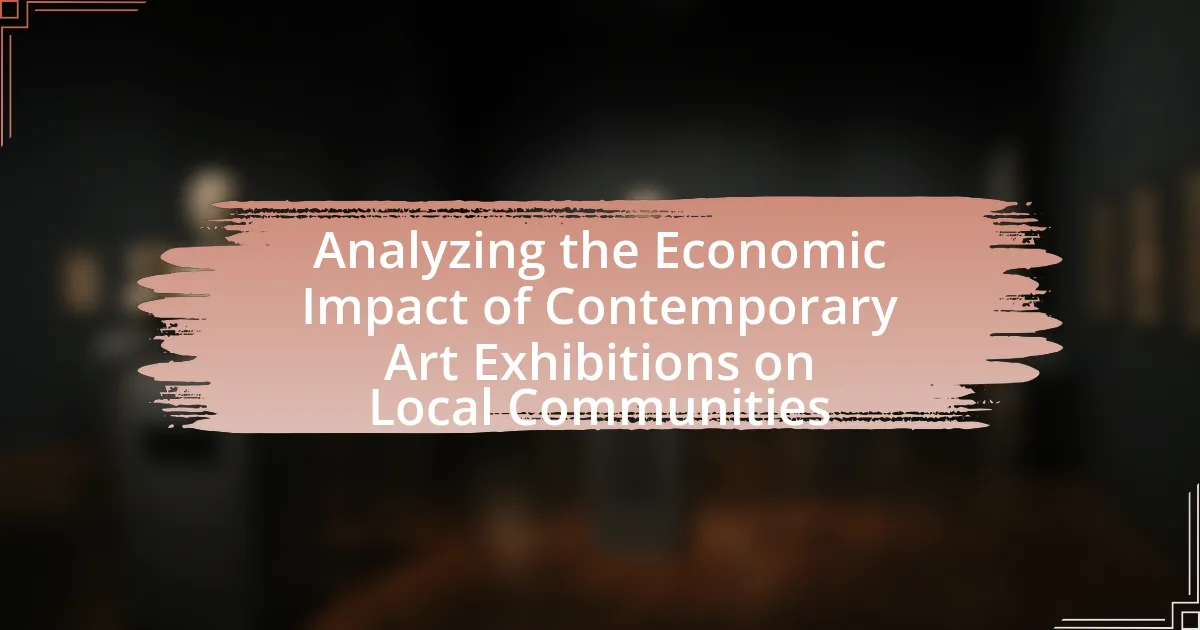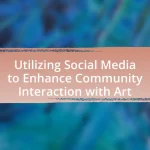The article analyzes the economic impact of contemporary art exhibitions on local communities, highlighting their role in boosting tourism, creating jobs, and stimulating local businesses. It presents findings from various studies, including those by the National Endowment for the Arts, which demonstrate that art exhibitions can significantly increase visitor spending and local employment rates. The article also discusses the direct financial benefits of hosting art exhibitions, the influence of visitor attendance on local businesses, and the importance of sponsorship and funding. Additionally, it addresses strategies for maximizing economic benefits and overcoming common challenges faced by communities in organizing art exhibitions.
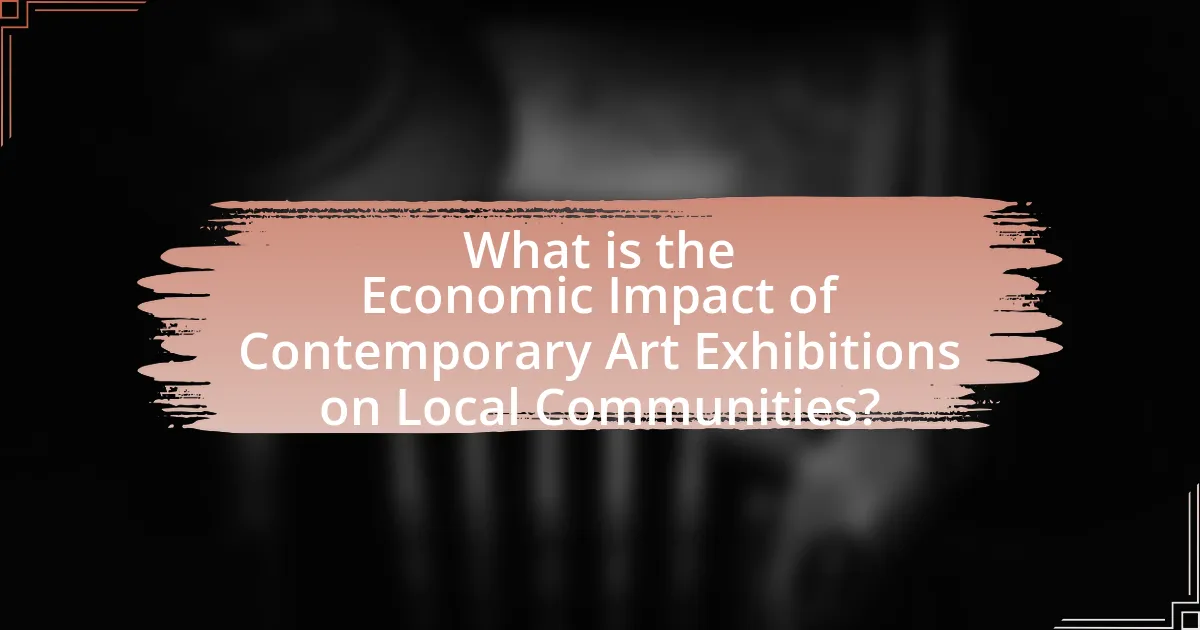
What is the Economic Impact of Contemporary Art Exhibitions on Local Communities?
Contemporary art exhibitions significantly boost local economies by increasing tourism, creating jobs, and stimulating local businesses. For instance, a study by the National Endowment for the Arts found that art exhibitions can attract thousands of visitors, leading to increased spending in hotels, restaurants, and shops. Additionally, these exhibitions often require local staffing, which creates employment opportunities in various sectors, including hospitality and retail. Furthermore, a report from the Arts Council England indicated that every £1 invested in the arts generates approximately £4 in economic returns, highlighting the substantial financial impact of contemporary art on local communities.
How do contemporary art exhibitions influence local economies?
Contemporary art exhibitions significantly influence local economies by driving tourism, increasing local spending, and creating job opportunities. These exhibitions attract visitors who spend money on accommodations, dining, and retail, thereby boosting local businesses. For instance, a study by the National Endowment for the Arts found that arts-related tourism contributes over $27 billion annually to the U.S. economy. Additionally, contemporary art exhibitions often require local staffing for event management, security, and hospitality, which creates employment opportunities. This economic activity not only enhances the financial viability of local businesses but also fosters community development and cultural enrichment.
What are the direct financial benefits of hosting art exhibitions?
Hosting art exhibitions generates direct financial benefits through increased revenue from ticket sales, art sales, and sponsorships. For instance, ticket sales can provide significant income, with some exhibitions generating thousands of dollars per event. Additionally, art sales during exhibitions can lead to substantial profits for both artists and galleries, contributing to the local economy. Sponsorships from businesses seeking to enhance their brand visibility can also provide financial support, often covering operational costs and increasing overall profitability. According to a study by the National Endowment for the Arts, art exhibitions can stimulate local economies by attracting visitors who spend on accommodations, dining, and retail, further amplifying the financial impact on the community.
How do art exhibitions affect local employment rates?
Art exhibitions positively affect local employment rates by creating jobs in various sectors, including hospitality, retail, and event management. For instance, a study by the National Endowment for the Arts found that art events can lead to a 20% increase in local employment during the exhibition period due to heightened visitor activity. This influx of visitors necessitates additional staffing in restaurants, hotels, and shops, thereby boosting overall employment in the community. Furthermore, art exhibitions often require local contractors and service providers, further contributing to job creation.
What role do art exhibitions play in community development?
Art exhibitions play a crucial role in community development by fostering cultural engagement and stimulating local economies. They attract visitors, which increases foot traffic and spending in nearby businesses, thereby enhancing economic vitality. For instance, a study by the National Endowment for the Arts found that arts-related events can generate significant revenue, with attendees spending an average of $27 per person on local goods and services. Additionally, art exhibitions promote social cohesion by bringing diverse groups together, encouraging dialogue, and enhancing community identity. This multifaceted impact underscores the importance of art exhibitions in driving both economic growth and social development within communities.
How can art exhibitions enhance local cultural identity?
Art exhibitions enhance local cultural identity by showcasing the unique artistic expressions and narratives of a community, thereby fostering a sense of pride and belonging among residents. These exhibitions often feature local artists and themes that reflect the history, traditions, and values of the area, which helps to solidify a shared cultural identity. For instance, a study by the National Endowment for the Arts found that communities with active art scenes experience increased civic engagement and social cohesion, as residents connect through shared cultural experiences. This connection not only strengthens local identity but also attracts tourism, further embedding the cultural significance of the community in the broader economic landscape.
What are the social benefits associated with contemporary art exhibitions?
Contemporary art exhibitions provide significant social benefits, including community engagement, cultural enrichment, and social cohesion. These exhibitions foster a sense of belonging by bringing diverse groups together, encouraging dialogue and collaboration among attendees. Research indicates that participation in cultural activities, such as art exhibitions, enhances social networks and promotes community identity. For instance, a study by the National Endowment for the Arts found that communities with active arts programs experience increased civic engagement and improved social ties. Additionally, contemporary art exhibitions often address social issues, prompting discussions that can lead to greater awareness and advocacy within the community.
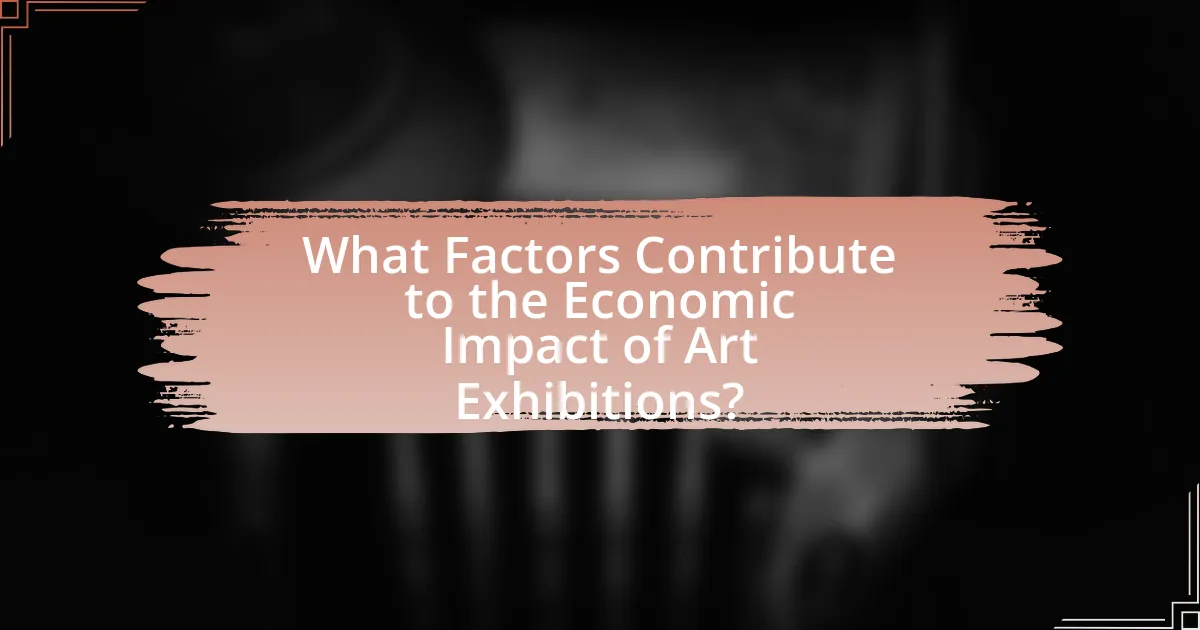
What Factors Contribute to the Economic Impact of Art Exhibitions?
The economic impact of art exhibitions is primarily influenced by factors such as visitor spending, job creation, and local business stimulation. Visitor spending encompasses ticket sales, merchandise purchases, and expenditures on accommodations and dining, which directly injects revenue into the local economy. For instance, a study by the National Endowment for the Arts found that art exhibitions can generate significant economic activity, with visitors spending an average of $25 per person per visit. Job creation occurs as exhibitions require staffing for operations, security, and maintenance, contributing to local employment rates. Additionally, art exhibitions stimulate local businesses, as increased foot traffic can lead to higher sales for nearby restaurants, hotels, and shops. Collectively, these factors demonstrate how art exhibitions serve as catalysts for economic growth within local communities.
How does visitor attendance affect local businesses?
Visitor attendance significantly boosts local businesses by increasing foot traffic and sales. When art exhibitions attract visitors, nearby restaurants, shops, and hotels experience higher patronage, leading to increased revenue. For instance, a study by the National Endowment for the Arts found that cultural events can generate up to $4 in economic activity for every $1 spent on the arts. This correlation demonstrates that higher visitor numbers directly translate to enhanced economic benefits for local enterprises, reinforcing the importance of contemporary art exhibitions in community economic development.
What types of businesses benefit most from increased foot traffic?
Retail stores, restaurants, and entertainment venues benefit most from increased foot traffic. These businesses thrive on customer visits, as higher foot traffic typically leads to increased sales and revenue. For instance, a study by the International Council of Shopping Centers found that a 10% increase in foot traffic can lead to a 5% increase in sales for retail stores. Additionally, restaurants often see a direct correlation between foot traffic and customer patronage, with busy areas attracting more diners. Entertainment venues, such as theaters and galleries, also gain from foot traffic, as more visitors can lead to higher ticket sales and increased engagement with local art exhibitions.
How does visitor spending influence the local economy?
Visitor spending significantly boosts the local economy by increasing revenue for businesses and generating tax income for local governments. When visitors attend contemporary art exhibitions, they spend money on accommodations, dining, transportation, and retail, which directly supports local businesses. For instance, a study by the National Endowment for the Arts found that arts-related tourism contributes billions to local economies annually, with each visitor spending an average of $100 per day. This influx of cash not only sustains existing jobs but also creates new employment opportunities, enhancing overall economic growth in the community.
What is the significance of sponsorship and funding for art exhibitions?
Sponsorship and funding are crucial for art exhibitions as they provide the necessary financial resources to cover operational costs, marketing, and artist compensation. These financial contributions enable exhibitions to be more ambitious in scale and scope, allowing for the inclusion of diverse artists and innovative works. For instance, a study by the National Endowment for the Arts found that funded exhibitions can attract larger audiences, which in turn stimulates local economies through increased tourism and spending in surrounding businesses. Additionally, sponsorship often enhances the credibility and visibility of the exhibition, leading to greater community engagement and support for the arts.
How do partnerships with local businesses enhance exhibition success?
Partnerships with local businesses enhance exhibition success by increasing visibility and attracting a larger audience. Collaborating with local businesses allows exhibitions to leverage their established customer bases, leading to higher foot traffic and engagement. For instance, a study by the National Endowment for the Arts found that local partnerships can boost attendance by up to 30%, as businesses promote the exhibition through their networks. Additionally, local businesses often provide resources, sponsorships, or promotional support, which can improve the overall quality and reach of the exhibition. This symbiotic relationship not only benefits the exhibition but also stimulates the local economy by driving sales and fostering community involvement.
What role do grants and public funding play in supporting art exhibitions?
Grants and public funding are essential for supporting art exhibitions by providing financial resources that enable the realization of diverse artistic projects. These funds help cover costs such as venue rental, artist fees, marketing, and installation expenses, which are often prohibitive for independent artists and small organizations. For instance, the National Endowment for the Arts in the United States allocates millions annually to support various art initiatives, demonstrating the significant impact of public funding on the arts sector. Additionally, studies show that exhibitions funded by grants often lead to increased local economic activity, as they attract visitors and stimulate spending in surrounding businesses.
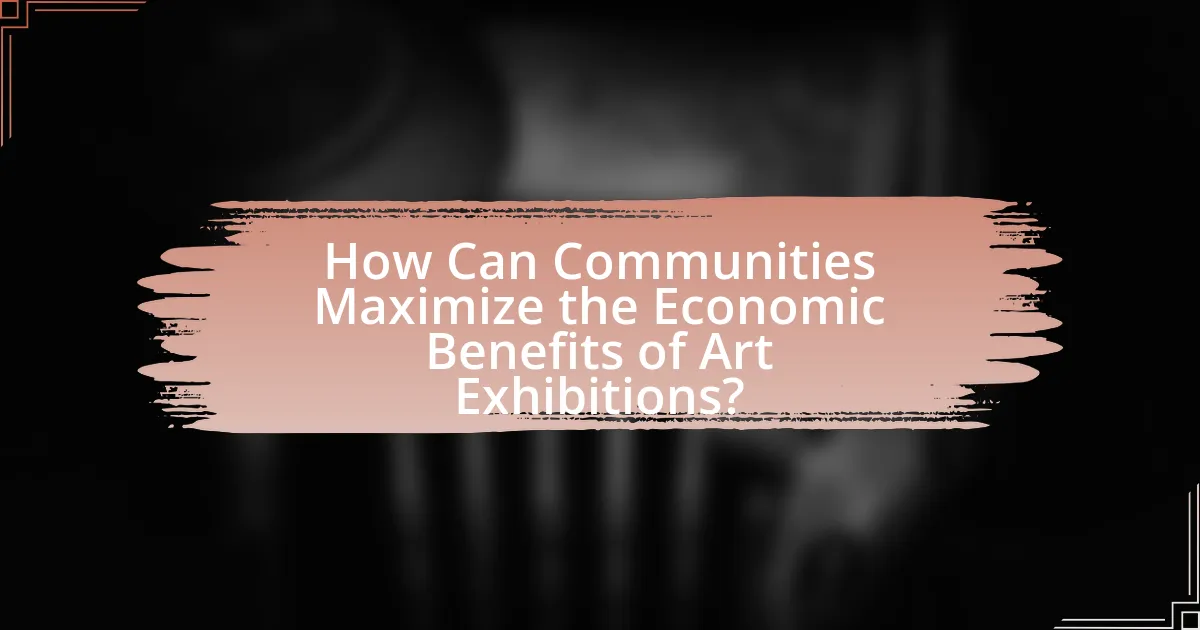
How Can Communities Maximize the Economic Benefits of Art Exhibitions?
Communities can maximize the economic benefits of art exhibitions by strategically promoting events, engaging local businesses, and enhancing visitor experiences. Effective promotion through social media and local advertising can increase attendance, directly boosting revenue for nearby restaurants, hotels, and shops. Collaborating with local businesses to offer discounts or packages during exhibitions encourages spending and fosters community involvement. Additionally, enhancing visitor experiences through guided tours, workshops, and interactive installations can attract a broader audience, leading to increased economic activity. Research indicates that art exhibitions can generate significant economic impact; for example, a study by the National Endowment for the Arts found that arts-related events can yield up to $4 in economic return for every $1 invested.
What strategies can local governments implement to support art exhibitions?
Local governments can implement strategies such as providing funding, facilitating partnerships, and promoting public spaces for art exhibitions. Funding can be allocated through grants or subsidies specifically aimed at local artists and art organizations, which can enhance the quality and reach of exhibitions. Facilitating partnerships between local businesses and artists can create sponsorship opportunities, increasing resources and visibility for exhibitions. Additionally, promoting public spaces, such as parks and community centers, for hosting art exhibitions can increase accessibility and community engagement, as evidenced by studies showing that public art initiatives can boost local economies by attracting tourism and enhancing community pride.
How can marketing efforts increase attendance at art exhibitions?
Marketing efforts can significantly increase attendance at art exhibitions by utilizing targeted advertising, social media engagement, and community partnerships. Targeted advertising reaches specific demographics likely to attend, enhancing visibility and interest. For instance, a study by the National Endowment for the Arts found that targeted marketing can increase attendance by up to 30% when aimed at local art enthusiasts. Social media engagement fosters a sense of community and excitement, with platforms like Instagram and Facebook allowing galleries to showcase artwork and events, leading to higher engagement rates. Additionally, partnerships with local businesses and organizations can create cross-promotional opportunities, drawing in diverse audiences. For example, collaborations with local cafes or schools can attract their patrons, further boosting attendance.
What partnerships can be formed to enhance community engagement?
Partnerships between local artists, community organizations, and educational institutions can significantly enhance community engagement. Local artists can collaborate with community organizations to create art projects that reflect the community’s identity, fostering a sense of belonging. Educational institutions can partner with these artists and organizations to develop programs that involve students in the creation and appreciation of art, thereby increasing participation and awareness. For instance, studies have shown that community art projects can lead to increased social cohesion and economic benefits, as seen in the “Art and Community Engagement” report by the National Endowment for the Arts, which highlights successful case studies of such collaborations.
What best practices should organizers follow to ensure economic success?
Organizers should implement strategic planning, effective marketing, and community engagement to ensure economic success. Strategic planning involves setting clear objectives, budgeting accurately, and assessing potential risks, which can lead to better resource allocation and financial outcomes. Effective marketing, including targeted outreach and social media campaigns, can increase attendance and visibility, directly impacting revenue. Community engagement fosters local support and participation, enhancing the exhibition’s relevance and appeal, which can lead to increased ticket sales and sponsorship opportunities. Research indicates that well-planned art exhibitions can generate significant economic benefits, with studies showing that cultural events can boost local economies by up to 10% through increased tourism and spending.
How can feedback from local businesses improve future exhibitions?
Feedback from local businesses can enhance future exhibitions by providing insights into community preferences and economic impacts. Local businesses often have a deep understanding of their customer base, which can inform exhibition themes, marketing strategies, and event timing to better align with community interests. For instance, a survey conducted by the National Endowment for the Arts found that 72% of local businesses reported increased foot traffic during art exhibitions, indicating that aligning exhibitions with local business needs can boost attendance and sales. By integrating this feedback, organizers can create more relevant and engaging exhibitions that not only attract visitors but also support the local economy.
What are the key metrics to evaluate the economic impact of art exhibitions?
The key metrics to evaluate the economic impact of art exhibitions include visitor spending, job creation, and tax revenue generation. Visitor spending quantifies the amount of money spent by attendees on accommodations, food, and transportation, which can significantly boost local economies; for instance, a study by the National Endowment for the Arts found that arts attendees spend an average of $27 per person, excluding the cost of admission. Job creation metrics assess the number of jobs supported by the exhibition, including direct employment at the venue and indirect jobs in surrounding businesses. Tax revenue generation measures the increase in local and state taxes resulting from the economic activity generated by the exhibition, which can be substantial; for example, a report from the Americans for the Arts indicated that arts and culture generate $27.5 billion in revenue for local, state, and federal governments annually. These metrics collectively provide a comprehensive view of the economic benefits derived from art exhibitions.
What are the common challenges faced by communities regarding art exhibitions?
Communities face several common challenges regarding art exhibitions, including funding limitations, lack of public engagement, and logistical issues. Funding limitations often hinder the ability to host high-quality exhibitions, as many communities rely on grants or sponsorships that may not be sufficient. Lack of public engagement can result in low attendance and diminished community interest, which affects the overall success of the exhibition. Logistical issues, such as securing appropriate venues and managing transportation of artworks, can complicate the planning process and lead to increased costs. These challenges collectively impact the economic benefits that art exhibitions can bring to local communities.
How can communities overcome funding limitations for art exhibitions?
Communities can overcome funding limitations for art exhibitions by leveraging partnerships with local businesses, applying for grants, and utilizing crowdfunding platforms. Collaborating with local businesses can provide mutual benefits, such as sponsorships or in-kind donations, which can significantly reduce costs. For instance, a study by the National Endowment for the Arts found that community partnerships can enhance funding opportunities and increase audience engagement. Additionally, applying for grants from arts foundations or government programs can provide essential financial support; in 2020, the National Endowment for the Arts awarded over $27 million in grants to support arts projects across the United States. Lastly, crowdfunding platforms like Kickstarter or GoFundMe allow communities to raise funds directly from supporters, fostering a sense of ownership and involvement in the art exhibition. These strategies collectively enable communities to secure necessary funding and promote vibrant art exhibitions.
What strategies can be employed to address community resistance to art exhibitions?
To address community resistance to art exhibitions, strategies such as community engagement, education, and collaboration with local stakeholders can be employed. Community engagement involves actively involving residents in the planning and execution of exhibitions, which fosters a sense of ownership and reduces resistance. Education initiatives can clarify the benefits of art exhibitions, such as increased tourism and local economic growth, as evidenced by studies showing that art events can boost local economies by up to 20%. Collaborating with local businesses and organizations can also create a supportive network that highlights the positive impacts of art on community identity and cohesion.
